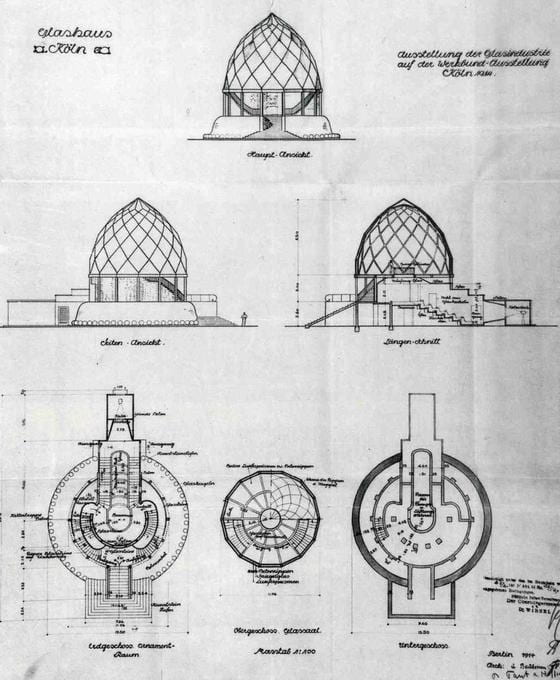During the lecture of week 7, Bruno Taut and his 1914 creation, The Glass Pavilion, were introduced. He created this structure for the Cologne Deutscher Werkbund Exhibition. Professor Thomaï Serdari was interrupted with a question from a fellow student who asked, “what does it mean to be faceted?” Which got me thinking about faceted glass and the large use of glass within buildings. It reminded me of a building that we looked at in past weeks (specifically week 5), Otto Wagner’s Vienna Post Office Savings Bank, 1904.

(^ https://www.pinterest.com/pin/478366791651671275/?nic=1a ^)
Both buildings being very modern for their time, used faceted ceilings as well as glass flooring. I decided to research these two buildings and compare them which brought me to the book, Encyclopedia of Twentieth-Century Architecture, by R. Stephen Sennott. On page 515 it is quoted “…. contemporary use of glass can be found in Otto Wagner’s Post Office Savings Bank (1905) in Vienna, with its glazed roof and floor, which borrowed from the Parisian arcades in anticipation of the modern atrium now seen so often in office buildings and hotels.” (pg. 515) Shortly after this quote the author speaks on Bruno Taut’s building, that he designed “a faceted, multicolored bishop’s hat of a glass dome raised on a drum of glass bricks.” (pg. 516)
I thought it was interesting to see two buildings from different times that incorporated the same techniques, details, and materials, such as the use of glass tiles. The glass tiles were used in similar ways on the floor, however Taut used them around the entire building. This brought the light not just from the basement as well as other rooms of the Pavilion, which was the same idea behind the glass tiled flooring within Wagner’s bank building.
I would like to continue to searching for architecture and interiors that we talk about in class and compare it with other buildings with the same idea and/or philosophy behind designing them.
Citation:
Sennott, Stephen R. Encyclopedia of 20th Century Architecture. New York: Fitzroy Dearborn, 2004.
https://books.google.com/books?id=wmiKGeBNWzAC&pg=PA515&lpg=PA515&dq=Otto+Wagner+Vienna+Post+Office+Savings+Bank+faceted+ceiling&source=bl&ots=jWcySFUhck&sig=ACfU3U2b7YI06MuAIejNb_dL_s9z2zFW4g&hl=en&sa=X&ved=2ahUKEwiKqt7fxLDlAhUpmuAKHYcDD18Q6AEwD3oECAkQAQ#v=onepage&q=Otto%20Wagner%20Vienna%20Post%20Office%20Savings%20Bank%20faceted%20ceiling&f=false
Photograph. n.d. Https://Www.pinterest.com/Pin/478366791651671275/?Nic=1a.

